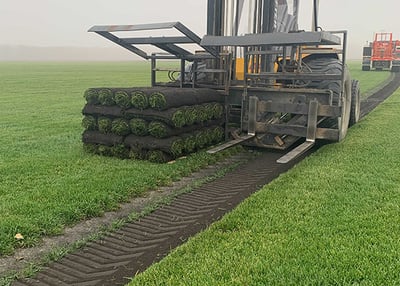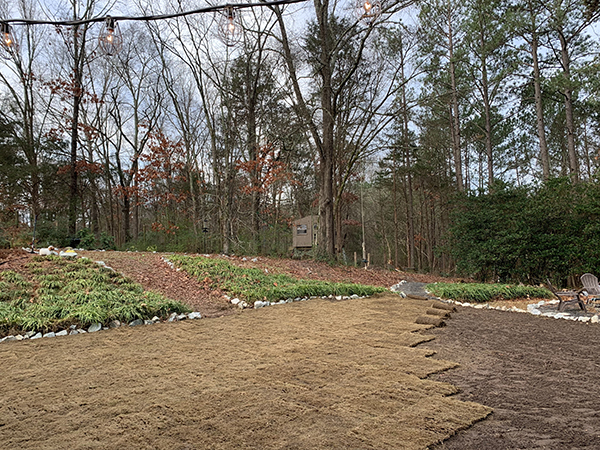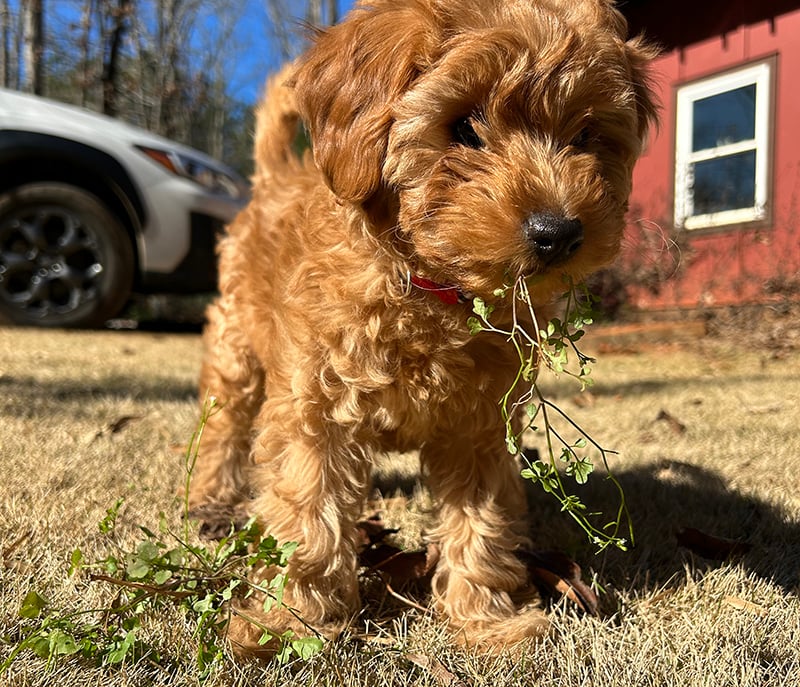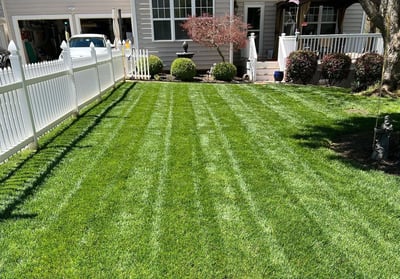

💤 Your warm season lawn should be fast asleep by now, especially after the 20 degree nights toward the end of December. Read on for all of Super-Sod's January lawn tips for dormant Bermuda, Centipede, and Zoysia lawns in the Southeast.
☃️ If you lit fireworks on your dormant warm season lawn and now see some burn marks, don't worry it can be fixed. Read more on Lawn Care for Inflatables and Fireworks During Winter Holidays.
You Can Lay Dormant Sod in January
If bare spots are driving you crazy or you have made renovations, you can stop all that mud by laying dormant warm season sod. No problem! Laying dormant sod in winter is "a thing." We do recommend you read our article on laying dormant sod for a few important tips.
💻 You can order individual rolls or full pallets right here in our online store.
Rake or Blow Leaves off all Lawns
This should have been done all throughout the fall; so if you haven't done it yet, remove tree leaves from your lawn to prevent suffocation and diseases, even from dormant lawns. Rake or blow them into your beds and natural areas to use them as mulch rather than bagging them. Leaves are also a good addition to the compost pile.
👉 Read more about Using Fall Leaves in the Garden.
Fertilizing Tips for Warm Season Lawns
- Do not fertilize or aerate warm-season lawns in winter; wait until spring when you see your lawn green up. We'll give you the go-ahead at that time.
- Resist "weed and feed" and "winterizer" marketing. Weed and feed pre-emergent combos are not not effective at reducing weeds this time of year and winterizers usually contain high nitrogen.
- To emphasize: your lawn is dormant, so don't apply a product with high nitrogen. Why not? Nitrogen's job is to promote fresh, green growth and you don't want tender, new growth when there are frosty temperatures lurking. That new growth will get zapped by the frost, causing your lawn to struggle. Let it sleep through the winter.
- Fertilizer products with phosphorus and potassium are safe, but there's not much reason to apply them unless they are included in a pre-emergent herbicide. But wait! The best time to apply pre-emergents for summer weeds is in February so we'll prompt you next month.
Weeding Tips for Warm Season Lawns
- Clare Lewis, Customer Experience Leader for Lawn Coach, wrote a piece to help you manager the winter weeds you're seeing right now. Read Tackling Winter Weeds.
- Post-emergent herbicides for weeds you can see now in warm season lawns are tricky this time of year because they won't work if it's too cold out.
- 👍 Rule of thumb #1: Most post-emergents work best above 65 degrees so you should time application around weeks that are above 65 degrees. We have post-emergents in stock, but whatever you use read the label and follow all instructions.
- 👍 Rule of thumb #2: Don't spray a non-selective herbicide (such as a glyphosate product, i.e. RoundUp) if your grass has any green because a non-selective will kill any plant it touches. Instead, choose mowing and hand weeding to protect the health of your lawn. If you live in a colder region and your warm season lawn is truly dormant and all tan-colored, then it's probably safe to apply a non-selective post-emergent herbicide on your dormant lawn. We have post-emergents in stock, but, again, read the label and follow all instructions.
- Mowing a dormant lawn is not a silly thing to do! In fact, if you didn't apply pre-emergent herbicide earlier in the fall, it's one of the best solutions you have for combating winter weeds. Mowing in winter is a smart way to suppress weeds because it cuts off flower/seed heads and that stops weeds from making more weeds, thus breaking the life cycle. If you have bad winter weeds, mow on a weekly routine and don't let the weeds get ahead of you.
- The window for applying pre-emergent herbicide for summer weeds will open next month when the Forsythia bushes flower. We'll send you a reminder email alert at that time. Sign up for Lawn Coach and we'll ship you pre-emergent when it's time.
- Mulch is a time-tested trick for suppressing weeds in flower beds. Spread bark or pine straw 2-4" thick and keep it 1-2" away from touching the trunks or stems of your plants. Rake/blow leaves off your lawn and into your beds and natural areas rather than bagging them.
- Hand weeding gets you outside! If you spend a lot of time in front of screens, hand pulling those winter weeds is a good motivator to get out for some Vitamin D therapy.
Featured Weed - Bittercress
I'm already seeing hairy bittercress flowers and, not only that, a few are even producing seeds! This is earlier than I've ever seen them seeding, probably because of the mild December temperatures.
Click here to learn all about hairy bittercress and why I don't worry about my pup Rosie "helping" me while I hand weed some stray bittercress out of my Zoysia.

Mowing Tips
- Nothing to mow this month, unless you need to mow any winter weeds that are thriving.
- If you have not done so already, "winterize" your mower by:
- Cleaning off plant debris
- Draining gas so it doesn't sit with stale gas all winter
- Purchasing spark plug, oil, air filter, and fuel filter so you have them handy to change out before mowing season
- Sharpening or replacing your mower blades in preparation for when spring mowing commences
Come back next month for February Lawn Tips for Warm Season lawns!
If you have a Tall Fescue lawn (the best cool season lawn for the Southeast), read all our January tips for Tall Fescue lawns.
Got questions? Leave a comment below!
New here? Subscribe to our emails to get this information in your inbox every month.






